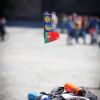- Accede I
- Regístrate I
- carrito
Vestimenta y equipaje
Si en la edad media los caminantes se echaban a andar con apenas un zurrón, un bordón o cayado para apoyarse, una capa para resguardarse y una vieira al pecho como señal de identidad, hoy la preparación de la vestimenta y el equipaje deben realizarse con cuidado, en función de la época en que se realice el Camino, la modalidad escogida y el tiempo previsto de caminata.
La elección de la mochila es uno de los puntos clave: debe ser del tipo anatómico, con sujeción a las caderas, de unos 40 litros de capacidad y con compartimientos numerosos para no tener que deshacerla por completo cada vez que se quiere sacar algo. Los elementos más pesados se colocan más cerca de la espalda; el saco de dormir, la esterilla y la capa de lluvia, en un compartimiento inferior externo, y la documentación muy a mano.
El límite de peso que se puede cargar en la mochila suele establecerse en un 10% de nuestro peso: en todo caso, no más de 8 kilos para mujeres y 10 para hombres. Muchos peregrinos optan por llevar mayor cantidad de equipaje en un coche de apoyo o en enviar por correo, desde casa, distintos bultos de equipaje a lugares concertados.
El calzado también es una elección fundamental. Mientras en primavera y verano puede caminarse con zapatillas de deporte de suela gruesa, medio número más grandes de lo necesario (para prever hinchazones), en otoño e invierno es imprescindible llevar botas de trekking, de caña media, que sujeten el tobillo. Es importante no estrenarlas en el camino y haber entrenado con ellas en casa.
Además de la ropa adecuada para la temporada, debe contarse con incluir en el equipaje un botiquín de primeros auxilios básico, especialmente centrado en el cuidado de los pies.
La bicicleta permite añadir alforjas, pero también implica cargar con llaves, bomba de aire y utensilios de limpieza del vehículo, entre otros. Los jinetes tendrán que contar además con los implementos del caballo y su botiquín de salud e higiene.










